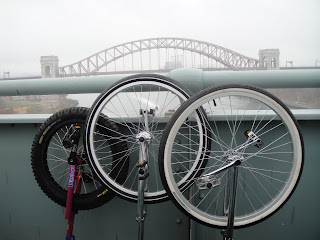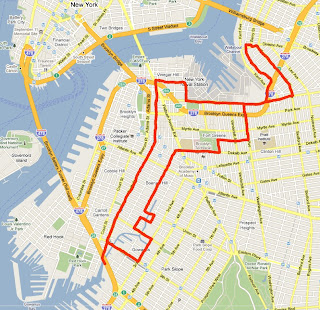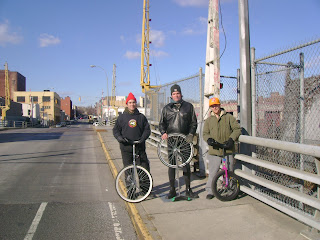

Robert F. Kennedy Bridge (Triborough Bridge), November 25, 2009
Kyle Petersen on an 20", Keith Nelson on a 26", Rob Hickman on a 24"
View on Unicycle NYC Bridge Tour Map at:
unibridgetour.net
On a chilly November morning drenched with fog, we set out to cross Robert Moses's infamous Triborough bridge. The Triborough consists of three spans. The first and longest goes from Astoria Queens to Randalls island, high up over Hell Gate- where Long Island Sound meets the East River. The second span bridges the trickling Bronx Kill and a series of railroad tracks between Randall's Island and the Bronx. The third span goes from Randall's Island to Manhattan, crossing the Harlem River. We had a difficult time finding the unicycle path for this section. Worth noting was the team of construction workers who enjoyed our shenanigans on the first span. The handrail on this section was particularly low, adding vertigo to the challenge. In addition to the Triborough, we enjoyed a lovely pedal along the East River down to and across the narrow Randall's Island pedestrian bridge.

From Wikipedia:
The Robert F. Kennedy Bridge better known as the Triborough Bridge is a complex of three separate bridges in New York City. Spanning the Harlem River, the Bronx Kill, and the Hell Gate (part of the East River), the bridges connect the boroughs of Manhattan, Queens, and The Bronx via Randall's Island and Ward's Island, which are joined by landfill. Often historically referred to as simply the Triboro, the spans were officially named after Robert F. Kennedy in 2008.
Plans for connecting Manhattan, Queens and the Bronx were first announced by Edward A. Byrne, chief engineer of the New York City Department of Plant and Structures, in 1916. While its construction had been long recommended by local officials, the Triborough Bridge did not receive any funding until 1925, when the city appropriated funds for surveys, test borings and structural plans. Construction had begun on Black Friday in 1929, and the Triborough project's outlook began to look bleak. Othmar Ammann's assistance was enlisted to help simplify the structure. Ammann had collapsed the original two-deck roadway into one, requiring lighter towers, and thus, lighter piers. These cost-saving revisions saved $10 million on the towers alone. Using New Deal money, the project was resurrected in the early 1930s by Robert Moses and the bridge was opened to traffic on July 11, 1936. Its cost was greater than that of the Hoover Dam. The structure used concrete from factories from Maine to Mississippi. To make the formwork for pouring the concrete, a whole forest in Oregon was cut down.
The bridge is owned by the City of New York and operated by the Triborough Bridge and Tunnel Authority (TBTA), an affiliate agency of the Metropolitan Transportation Authority (New York). At some point in the past, a sign on the bridge informed travelers, "In event of attack, drive off bridge", New York Times columnist William Safire wrote in 2008. The "somewhat macabre sign", he wrote, must have "drawn a wry smile from millions of motorists." On November 19, 2008, and pursuant to a request made by the Kennedy family, the Triborough Bridge was officially renamed after Robert F. Kennedy, who served New York as a senator, 40 years after his assassination. Since then, the term RFK-Triborough has become increasingly popular as a nickname for the bridge, with typical traffic reports using the name.
The toll revenues from the Robert F. Kennedy Bridge pay for a portion of the public transit subsidy for the New York City Transit Authority and the commuter railroads. The bridge carries approximately 200,000 vehicles per day. The bridge has sidewalks in all three legs where the TBTA officially requires bicyclists to walk their bicycles across due to safety concerns. However, the signs stating this requirement have been usually ignored by bicyclists, while the New York City Government has recommended that the TBTA should reassess this kind of bicycling ban. Stairs on the 2 km (1.3 mile) Queens leg impede handicapped access. The Queens stairway along the southern side was demolished at the beginning of the 21st century, thus isolating that walkway, but the ramp of the Wards Island end of the walkway along the northern side was improved in 2007. The two sidewalks of the Bronx span are connected to only one ramp at the Randalls Island end. The Triborough Bridge and Tunnel Authority announced a toll increase on its facilities, effective March 16, 2008. The cash charge for passenger vehicles to cross the Triborough raised to $5.00 (from $4.50) in any direction. The toll for E-ZPass users raised to $4.15 (from $4.00). The crossing charge for a motorcycle raised to $2.25 (from $2.00), with motorcycle E-ZPass tolls rising to $1.81 (from $1.75). The return trip from Randall's Island to any borough is free. The Triborough Bridge and Tunnel Authority announced a toll increase on its facilities, effective July 12, 2009. The cash charge for passenger vehicles to cross the Triborough raised to $5.50 (from $5.00) in any direction. The toll for New York State E-ZPass users raised to $4.57 (from $4.15). The crossing charge for a motorcycle raised to $2.50 (from $2.25), with motorcycle tolls with a New York State E-ZPass rising to $1.99 (from $1.81). No discount is provided for out-of-state E-ZPasses. The return trip from Randall's Island to any borough is free.
The three sections of the bridge:
East River suspension bridge (I-278)
Span crosses the East River at the Hell Gate between Queens and Ward's Island
Connects to Grand Central Parkway and Brooklyn-Queens Expressway
Length of main span: 1,380 feet (421 m)
Length of each side span: 700 feet (213 m)
Length, anchorage to anchorage: 2,780 feet (847 m)
Width of bridge: 98 feet (30 m)
Number of traffic lanes: 8 lanes
Height of towers above mean high water: 315 feet (96 m)
Clearance at center above mean high water: 143 feet (44 m)
Number of sidewalks: 1
Harlem River lift bridge (NY Reference Route 900G)
Span crosses the Harlem River between Manhattan and Randall's Islands
Connects to Harlem River Drive, FDR Drive, and 125th Street
Length of main lift-truss span: 310 feet (94 m)
Length of each side truss span: 230 feet (70 m)
Length, anchorage to anchorage: 770 feet (235 m)
Height of towers: 210 feet (64 m)
Clearance of lift span above mean high water: 55 feet (17 m)
Clearance of lift span in raised position: 135 feet (41 m)
Number of traffic lanes: 6 lanes
Number of sidewalks: 2 (1 on each side)
Bronx Kills crossing (I-278)
Span crosses the Bronx Kill between The Bronx and Randall's Island
Connects to Major Deegan Expressway and Bruckner Expressway
Length of main truss span: 383 feet (117 m)
Length of approach truss span: 1,217 feet (371 m)
Length, anchorage to anchorage: 1,600 feet (488 m)
Clearance of truss span above mean high water: 55 feet (17 m)
Number of traffic lanes: 8 lanes
Number of sidewalks: 2 (1 on each side)




















